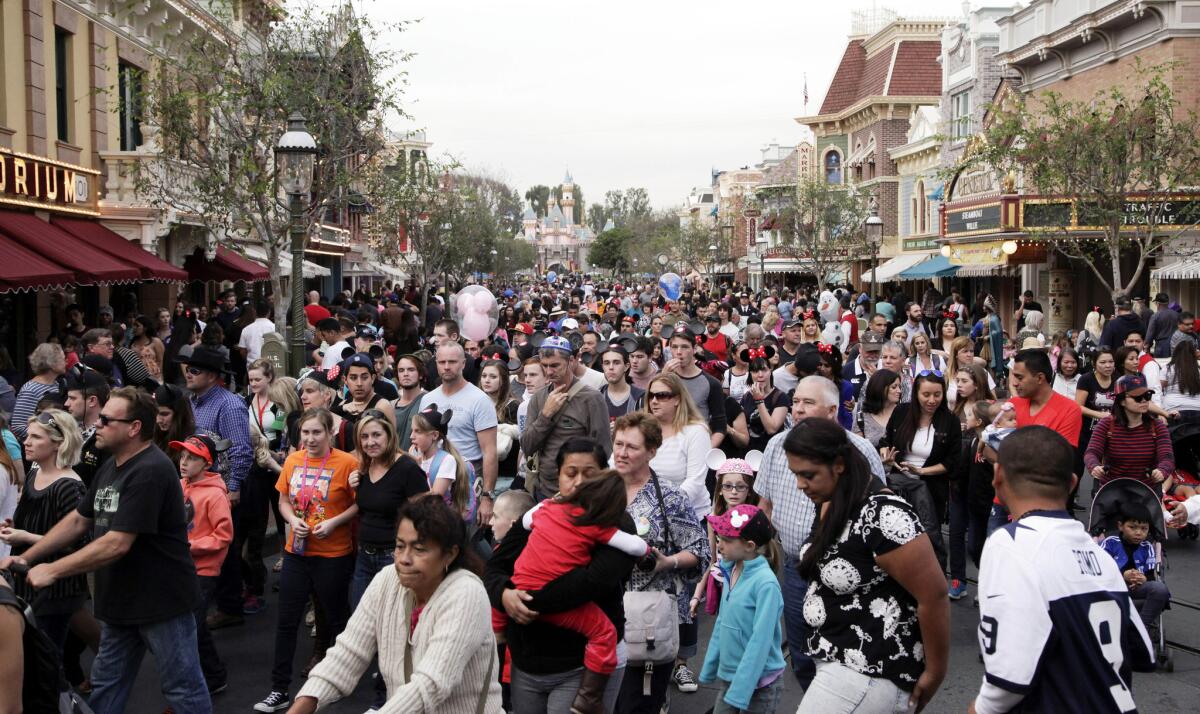The Whiteboard Jungle: If you go to Disneyland, prepare to spend a lot of money
- Share via
Many families cherish the memories of taking their children to Disneyland for the first time. I just experienced what in all likelihood will be my last.
This week, my wife and I treated our youngest son to an overnight trip at the Disneyland Hotel. A stay in a small 364-square-foot room is $595 with tax. This luxurious cost should be reserved for a four-star hotel in Midtown Manhattan.
But I was just warming up my credit card.
This month, Disney introduced tiered pricing, three different prices contingent on attendance figures. Instead of the old $99 any-day price, now Disneyland charges $95 for “value” days, $105 for “regular” days, and $119 for “peak” days.
The rationale is that by charging more during busier periods, fewer people will go, thus lessening the crowds.
So far, it’s not working.
The souvenirs rank slightly higher than those found at a carnival midway ... It’s like buying Target-like clothes at Nordstrom’s prices among Black Friday-level crowds.
— Brian Crosby
Just our luck we happened to go on a “peak” day, paying 20% more than if we had visited a couple of days earlier. And the whole area from Downtown Disney to lines for rides and food was clogged with people.
A family of four will have to budget a one-day trip to the Magic Kingdom on a peak day as if it were a three-day excursion elsewhere.
First, just to walk through the gates is $476. Each meal with drink costs around $20, meaning for four people, one meal is $80; multiplied by three, the total food tab soars to $240. Add $80 for souvenirs and snacks and $18 for parking and the whole day at Disneyland costs a family of four $814.
That nearly matches the gross median weekly earnings of an American, “$825 in the fourth quarter of 2015” as reported by the Bureau of Labor Statistics.
And with the ubiquitous crowds, lines lasting up to two hours for a ride, it is doubtful that they will get to experience one-quarter of the 58 attractions.
I would not mind paying an extra $20 if the Disney company would guarantee fewer people. But they do not.

People crowd Main Street at Disneyland in Anaheim, Calif. in this file photo from Jan. 22, 2015.
The “you-get-what-you-pay-for” adage does not apply here. Except for the rides, nothing at Disneyland is of high quality.
The souvenirs rank slightly higher than those found at a carnival midway, and the food, whether bought at a stand or a sit-down restaurant, is the same caliber — average — at an exorbitant price.
It’s like buying Target-like clothes at Nordstrom’s prices among Black Friday-level crowds.
It is not just the $4.25 for a churro that ruins the experience; it is the line of 10 people waiting to buy one.
There is only one way to improve the Disneyland experience and that is to limit the number of people coming into the park. Only on rare occasions does Disney do this, when attendance reaches around 65,000 people.
Here’s a marketing suggestion: limit capacity to 30,000, but charge $300. I bet there would not be a shortage of people going for that promotion. Of course, by limiting attendance you are also limiting sales in food and souvenirs.
When my brother worked for Disney, he revealed an internal acronym widely circulated: GTG — Gouge the Guest.
According to Disney, its theme park division earned $2.2 billion in profits in 2013.
Ultimately, my son had a wonderful time. But at $1,200 for this 24-hour excursion (that’s $50 an hour), I’ve had my last “yo-ho-yo-ho.”
Disneyland employees are trained to tell customers, “Have a magical day!” Magic has its price.
--
BRIAN CROSBY is a teacher in the Glendale Unified School District and the author of “Smart Kids, Bad Schools” and “The $100,000 Teacher.” He can be reached at briancrosby.org.
